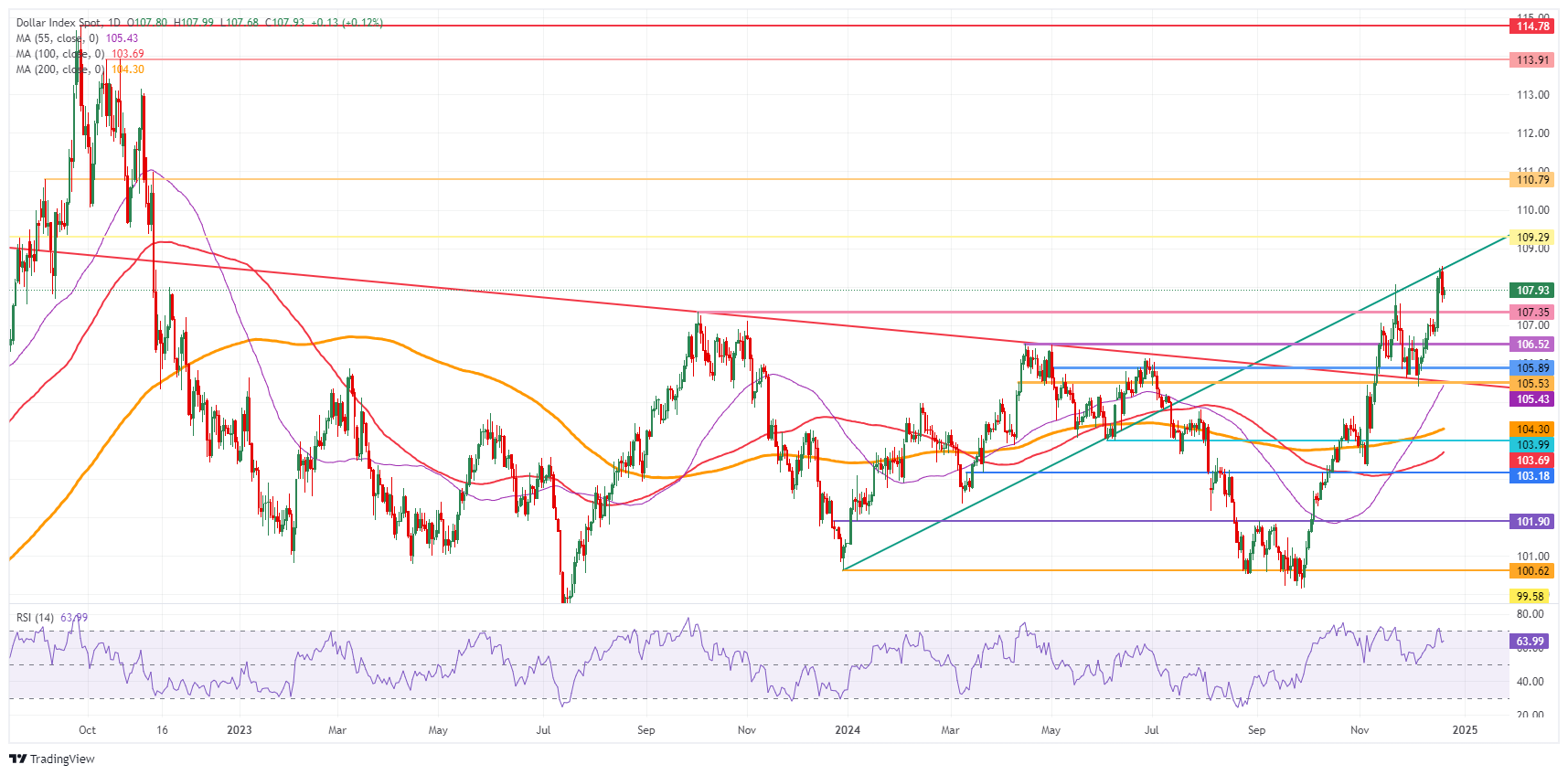US Dollar trades positive at start of holiday-shortened Christmas week
- The US Dollar trades broadly steady on Monday amid lighter trading conditions.
- Friday’s PCE inflation release rekindles expectations for the Fed’s rate cut projections in 2025.
- The US Dollar Index (DXY) resides just below 108.00, with the recent two-year high in reach.
The US Dollar (USD) is off to a positive start on Monday, with the DXY Index hovering above 108.00, on the last normal trading day ahead of Christmas. The USD took a hit on Friday after rate cut projections for the Federal Reserve (Fed) in 2025 got some support after a rather soft Personal Consumption Expenditures (PCE) inflation print. Equity markets were in a positive tone on Monday, with Asian indices snapping a losing streak and set to close off on the front foot, while sentiment is now changing with a rebouding Greenback in the European trading session.
The US economic calendar features some minor data releases on Monday: the Chicago Fed National Activity Index and the Conference Board Consumer Confidence. The calendar will be more full on Tuesday, with the November Durable Goods and New Home Sales data, before enjoying the Christmas dinner..
Daily digest market movers: Final drips
- A government shutdown was averted on Friday in the very final hours. The White House announced on Saturday that US President Joe Biden had signed the legislation, which funds the government through mid-March.
- At 13:30 GMT, the Chicago Fed National Activity Index for November is due. No consensus view with the previous print at -0.4.
- At 15:00 GMT, the US Consumer Confidence index for December will come out.
- The US Treasury will have its work cut out this Monday with four auctions: At 16:30 GMT, a 3-month, a 52-week and a 6-month bill will be allocated in the markets. At 18:00 GMT, a 2-year Note will be auctioned.
- Asian equities are doing quite well, ending their six-day losing streak. European equities are still looking sluggish, whereas US futures are in the green.
- The CME FedWatch Tool for the first Fed meeting of 2025 on January 29 sees a 91.4% chance for a stable policy rate against a small 8.6% chance for a 25 basis points rate cut.
- The US 10-year benchmark rate trades at 4.53%, just below the 4.59% high from last week.
US Dollar Index Technical Analysis: Final straw
The US Dollar Index (DXY) is set for the final normal trading day before Christmas with a rather light calendar ahead. Traders will change their strategy and will likely only trade short-term moves. So, keep in mind that any moves could be short-lived and face quick profit-taking.
On the upside, a trend line originating from December 28, 2023, is acting as a moving cap. The next firm resistance comes in at 109.29, which was the peak of July 14, 2022, and has a good track record as a pivotal level. Once that level is surpassed, the 110.00 round level comes into play.
The first downside barrier comes in at 107.35, which has now turned from resistance into support. The second level that might be able to halt any selling pressure is 106.52. From there, even 105.53 could come under consideration while the 55-day Simple Moving Average (SMA) at 105.23 is making its way up to that level.
US Dollar Index: Daily Chart
US Dollar FAQs
The US Dollar (USD) is the official currency of the United States of America, and the ‘de facto’ currency of a significant number of other countries where it is found in circulation alongside local notes. It is the most heavily traded currency in the world, accounting for over 88% of all global foreign exchange turnover, or an average of $6.6 trillion in transactions per day, according to data from 2022. Following the second world war, the USD took over from the British Pound as the world’s reserve currency. For most of its history, the US Dollar was backed by Gold, until the Bretton Woods Agreement in 1971 when the Gold Standard went away.
The most important single factor impacting on the value of the US Dollar is monetary policy, which is shaped by the Federal Reserve (Fed). The Fed has two mandates: to achieve price stability (control inflation) and foster full employment. Its primary tool to achieve these two goals is by adjusting interest rates. When prices are rising too quickly and inflation is above the Fed’s 2% target, the Fed will raise rates, which helps the USD value. When inflation falls below 2% or the Unemployment Rate is too high, the Fed may lower interest rates, which weighs on the Greenback.
In extreme situations, the Federal Reserve can also print more Dollars and enact quantitative easing (QE). QE is the process by which the Fed substantially increases the flow of credit in a stuck financial system. It is a non-standard policy measure used when credit has dried up because banks will not lend to each other (out of the fear of counterparty default). It is a last resort when simply lowering interest rates is unlikely to achieve the necessary result. It was the Fed’s weapon of choice to combat the credit crunch that occurred during the Great Financial Crisis in 2008. It involves the Fed printing more Dollars and using them to buy US government bonds predominantly from financial institutions. QE usually leads to a weaker US Dollar.
Quantitative tightening (QT) is the reverse process whereby the Federal Reserve stops buying bonds from financial institutions and does not reinvest the principal from the bonds it holds maturing in new purchases. It is usually positive for the US Dollar.

